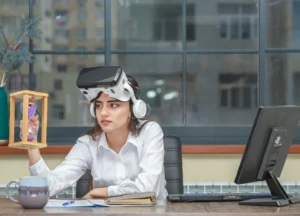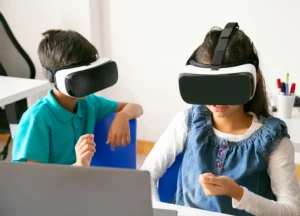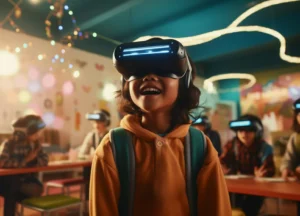The Future of Training and Education: How AR/VR is Changing Learning Experiences
In today’s fast-evolving digital world, Reality Augmented(AR) and Virtual Reality (VR) are making remarkable strides in revolutionizing education and training. Once the domain of gaming and entertainment, AR and VR have broken into new ground by transforming how students learn and professionals are trained. With immersive, hands-on learning experiences, these technologies are providing a level of engagement and interaction that traditional methods simply cannot match. Let’s explore how AR/VR is shaping the future of training and education and why it holds tremendous potential for learners and educators alike.
1. Enhanced Engagement and Interactivity
-
- Traditional learning environments often struggle to maintain high levels of student engagement. However, AR and VR allow students to experience a new depth of immersion by interacting directly with 3D simulations and scenarios. For instance, a history lesson becomes a time-travel adventure where students can virtually explore ancient cities, or a science class turns into a journey inside the human body. This kind of interactive, engaging experience captures attention more effectively than traditional lectures, enabling better knowledge retention.
2. Learning by Doing: Hands-On Practice in a Safe Environment
One of the standout features of VR in education is the ability to create a “learning by doing” approach. In fields such as medicine, engineering, and aviation, VR allows students to practice procedures and techniques without real-world consequences. For example:
-
-
- Medical students can perform surgeries in a virtual environment before they move on to working with patients.
- Engineering students can build and test structures in a simulated space, experimenting with their designs and understanding errors without risk.
- Pilots and astronauts can use VR simulations to train in high-risk situations safely.
-
This hands-on practice is invaluable, as it helps learners build confidence, improve their skills, and handle real-life scenarios effectively
3. Personalized Learning Paths
-
-
- In a traditional classroom, instructors may struggle to meet the needs of all students due to diverse learning speeds and styles. AR and VR can help bridge this gap by offering a personalized learning experience. VR simulations and AR apps often allow for adaptable lessons, where the difficulty level can be adjusted based on each student’s progress. This tailored approach enables students to learn at their own pace, giving them more control over their educational journey and enhancing their comprehension of complex topics.
-

4. Global Access to Quality Education
-
-
-
- AR and VR have the power to make high-quality education accessible to students regardless of their geographic location. For example, a student in a remote area with limited access to top-notch educational institutions can use VR headsets to participate in virtual classrooms with students from around the world. Similarly, professional training can be delivered virtually to employees in multiple locations, reducing the need for travel and increasing training efficiency. By bridging geographic divides, AR/VR in education is democratizing access to high-quality, immersive learning experiences.
-
-
5. Overcoming Language Barriers with Real-Time Translations
-
-
-
- With VR, language is no longer a barrier to global learning. Virtual environments can provide real-time translations, allowing students to learn from instructors around the world, regardless of language differences. For instance, a student in Japan could attend a virtual lecture led by a U.S.-based professor and see translated text and visuals in real time. This opens up a world of possibilities for students to access the best educational resources globally without language limitations.
-
-
6. Revolutionizing Teacher Training and Professional Development
-
-
-
- VR isn’t just for students—it’s also transforming the way educators and professionals are trained. Teacher training can be highly immersive with VR, allowing new educators to practice classroom management techniques and lesson delivery in a controlled environment. VR can simulate challenging scenarios, helping educators develop their skills and build confidence in managing real-life classroom dynamics. In professional sectors, employees can be trained on new equipment, technologies, and procedures through VR simulations, making it easier for organizations to upskill their workforce without interrupting daily operations.
-
-
7. Fostering Collaboration Through Virtual Classrooms
-
-
-
- AR and VR allow students to connect and collaborate in virtual classrooms, promoting social learning and teamwork. In a VR classroom, students can work together on projects, discuss ideas, and interact as if they were in a physical room, even if they’re miles apart. This virtual collaboration prepares students for a workforce that increasingly values digital communication skills and collaborative problem-solving. By fostering teamwork and communication in a virtual setting, AR/VR helps students develop critical soft skills that are essential in the modern workplace.
-
-


8. Transforming Assessment Methods
-
-
-
- Traditional exams and assessments may not fully capture a student’s understanding and application of knowledge. VR, however, can provide a more practical approach to assessments, allowing students to be evaluated based on their actions in a simulated environment. For example, a medical student could be assessed on how they handle a virtual emergency, or an engineering student could be evaluated on their ability to build a functional structure in VR. These kinds of assessments provide educators with a deeper insight into a student’s abilities and readiness for real-world scenarios.
-
-
9. AR/VR Technology: Making Learning Fun and Accessible
-
-
-
- The gamification element of AR and VR also adds a fun factor to learning. By incorporating elements of play, AR and VR make education more enjoyable and accessible, especially for younger students. Games and interactive quizzes in AR can help children learn difficult subjects, such as math or science, in a more engaging way. This gamified approach makes learning more attractive, helping to motivate students who may otherwise find traditional learning methods challenging.
-
-
10. Future Outlook: What’s Next for AR/VR in Education?
-
-
-
- As AR and VR technology continues to evolve, its potential in education and training will only expand. The integration of artificial intelligence (AI) with AR/VR is anticipated to further enhance personalized learning, enabling systems to respond dynamically to each learner’s progress and provide tailored feedback. As devices become more affordable and accessible, AR/VR will become mainstream in schools, universities, and workplaces, transforming traditional learning systems into highly adaptive, immersive experiences.
-
-
Conclusion
AR and VR are at the forefront of educational innovation, providing unparalleled benefits for students, educators, and professionals alike. With their ability to make learning more engaging, interactive, and accessible, these technologies are poised to shape the future of education. By investing in AR and VR, educational institutions and organizations can create an enriched learning environment that prepares students and employees for real-world challenges with confidence and skill. As the technology evolves, it’s clear that the future of learning will be immersive, experiential, and virtually limitless.
Follow us

